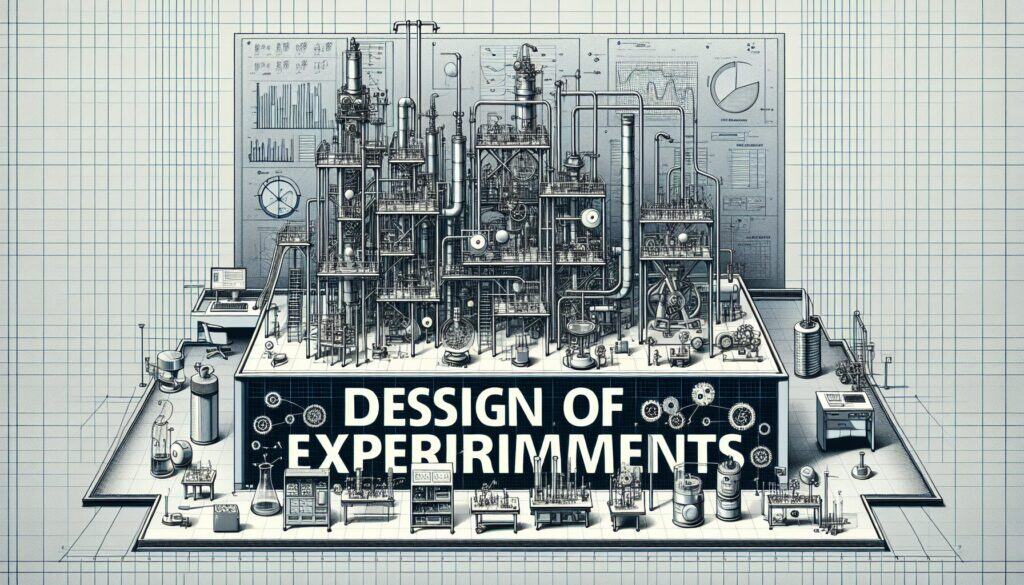A systematic statistical methodology to determine the relationship between factors affecting a process or product and the output of that process or product, by making planned changes to input variables and observing the effects on output variables.
- المنهجيات: الهندسة, تصميم المنتج, إدارة المشاريع
Design of Experiments (DOE)

Design of Experiments (DOE)
- تحليل التباين (ANOVA), التحسين المستمر, Design for Six Sigma (DfSS), تحسين التصميم, تحسين العمليات, مراقبة الجودة, إدارة الجودة, التحليل الإحصائي
الهدف:
كيفية استخدامه:
- Involves planning an experiment where multiple input factors (variables) are purposefully changed in a structured way to observe their individual and interactive effects on an output (response). Statistical analysis is then used to identify significant factors and optimal settings.
الإيجابيات
- Allows for studying multiple factors simultaneously, making it efficient; Can identify interactions between factors; Helps optimize processes and product designs for desired outcomes; Provides statistically valid conclusions.
السلبيات
- Can be complex to design and analyze, often requiring statistical software and expertise; May require a significant number of experimental runs, which can be costly or time-consuming; Assumes that all important factors have been identified.
الفئات:
- الهندسة, لين سيجما, التصنيع, حل المشكلات, تصميم المنتج, الجودة
الأفضل لـ
- Systematically investigating the effects of multiple variables on a process or product to optimize performance, solve problems, or improve designs.
Design of Experiments (DOE) methodology is frequently applied in industries such as pharmaceuticals, manufacturing, and agriculture, where optimizing processes is fundamental to success. In pharmaceuticals, DOE can be employed in formulation studies to understand how variations in ingredient concentrations impact drug efficacy and stability, thereby accelerating development cycles. In manufacturing, organizations utilize DOE during the product design phase to assess how changes in machine settings affect product quality, guiding improvements that reduce waste and rework. Agricultural scientists implement DOE to evaluate how factors like soil type, water, and fertilizer conditions influence crop yields, providing critical data for enhancing agricultural practices. This methodology is particularly beneficial in research and development contexts, where teams made up of engineers, scientists, and product managers come together to design experiments that analyze multiple variables concurrently, revealing intricate interactions that single-variable studies might overlook. It requires a structured approach to planning and execution, necessitating collaboration among stakeholders to determine which factors to investigate, ensuring the experiment aligns with project goals. Statistical analysis following the experimental phase allows teams to interpret results confidently, leading to well-informed decisions that optimize product performance or process efficiency based on robust evidence rather than anecdotal experience. Through careful planning, DOE stands out as a powerful tool for systematic investigation, offering a clear path for innovation and improvement across various sectors.
الخطوات الرئيسية لهذه المنهجية
- Identify the objectives and response variables of the experiment.
- Select input factors and their levels to investigate.
- Choose the appropriate experimental design (e.g., full factorial, fractional factorial, response surface method).
- Randomize the run order to minimize bias.
- Conduct the experiments as per the design.
- Analyze the data using statistical methods (e.g., ANOVA).
- Interpret the results to identify significant factors and interactions.
- Optimize settings to achieve desired outcomes.
نصائح للمحترفين
- Use fractional factorial designs when dealing with a large number of variables to reduce the total number of experiments while still obtaining useful information about main effects and interactions.
- Incorporate randomization in the experimental runs to minimize bias and improve the validity of results by eliminating systematic errors due to uncontrolled factors.
- Analyze residuals from the model to check for non-constant variance and outliers, ensuring that the assumptions of the statistical tests are met for reliable conclusions.
لقراءة عدة منهجيات ومقارنتها, نوصي باستخدام
> مستودع المنهجيات الشامل <
مع أكثر من 400 منهجية أخرى.
نرحب بتعليقاتكم على هذه المنهجية أو المعلومات الإضافية على قسم التعليقات أدناه ↓، وكذلك أي أفكار أو روابط متعلقة بالهندسة.
منشورات ذات صلة
Master Production Schedule (MPS)
Mass Customization
Marketing Funnel
Marketing Audit
MAPO Index (Movement and Assistance of Hospital Patients)
Manufacturing Resource Planning (MRP II)